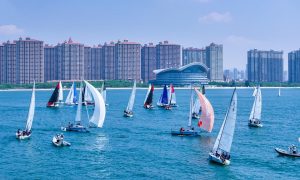Maritime history aficionado Austen Wilks delves into the annals of Penang to uncover an unrealised two-centuries-old plan to build a dockyard on Penang’s adjacent island of Jerejak.
Looking at Pulau Jerejak today across the narrow but deep channel that separates it from the larger island of Penang, you see dark green tropical foliage coming right down to the edge of the sea. The jungle seems to cover the whole island up to the hills, which are rounded granite ridges running roughly north-south, like those on its much larger parent island. In fact, it still looks very similar to a view from Penang Hill, painted around 1818.
Instead of this fragment that seems to be unchanged since prehistory, you could be looking – had the men described in this article been successful – at the Penang Dockyard. It would be a hive of bustling activity with workshops, warehouses (known as “go-downs” hereabouts), cranes, and the huge bulk of ship-building and repairing activities including construction slipways and dry docks.
There was a brief moment beginning in 1803 when Penang became a strategic pivot in a worldwide war, and was poised to become a “naval arsenal.” Of course, ships – such as the H.M. Brig ‘Viper’ with its 16 guns – had frequented these waters since the founding of the settlement. But there was no dockyard as such. After barely seven months of peace, the long war between post-revolutionary France and the United Kingdom had restarted. At this time, the island was already an important staging point for British ships of war of the East Indies fleet, as well as for the merchant convoys they were duty-bound to protect.
Almost the last act of the UK government that had negotiated that doomed peace was to send one of their own men to take over command of that fleet, and the transfer between Rear- Admirals Peter Rainier and Sir Edward Pellew took place at Penang in January 1805, a full seven months after the Admiralty orders were issued in London. This sort of delay, which meant that it might easily take a year for an appeal for clarification to be answered, was often used to advantage by wily officers in receipt of unwelcome orders.
Laying the Plans
On 30 June 1804, three men had met in Wimbledon (perhaps with a nautical sounding chart, showing the depths of the all-important channels in front of them), then a village to the southwest of London, to plan the future of Penang as a Royal dockyard with facilities to build and repair the largest ships. These men were Henry Dundas, who had been created Viscount Melville, his nephew Philip, and Paul Tate. Melville was the new government minister in charge of the Royal Navy; his nephew, a seasoned merchant captain with long experience in the east as a shipbuilding administrator, a man who would have been very familiar with a ship such as HCS (Hon Company Ship) Lord Lowther; and Tate, a Master Ship Builder who had served his apprenticeship in the UK Royal Dockyards.
Their plan was fully formed, witness a copy of a letter sent by Melville to Richard, Marquess Wellesley the EIC Governor-General in Calcutta. His thoughts on the need to extend overseas shipbuilding, sources of supplies of timber, location for the new dockyard at Pooloo Jerejah (now Pulau Jerejak),
and the two principal actors mentioned above were all explained. Melville now used his patronage at the East India Company (EIC) to secure his nephew’s appointment as the first full Governor at the Company’s outpost of Prince of Wales Island, as Penang was officially known. Once an independent and purely trading enterprise, like those set up in France, Holland, and Denmark for the same purpose, the EIC had now grown into a ruler of territory, its powers being slowly subsumed by amalgamation directly into the British government.
As First Lord of the Admiralty Melville then ordered a division in the East Indies command, appointing his friend, Rear-Admiral Sir Thomas Troubridge, to the larger eastern section, including Penang. Troubridge sailed in early 1805 carrying Dundas and his council of three (including as the junior, the young Stamford Raffles destined later to found Penang’s successor at Singapore) in a worn-out battleship, HMS Blenheim. This 45-year-old ship exemplified the need appreciated by Melville for huge supplies of shipbuilding timber to replace Britain’s depleted oak forests, which had largely been consumed and would have taken more than a century to replace even if land had been available to replant.
With the necessary official complications it would take another year for Tate to be ready to sail with two shiploads of materials for the dockyard, including a large (25 hp) steam engine with all its spares. This equipment, costing over £7,700, was paid for by the EIC after some negotiations with the Admiralty, and it arrived at Penang with Tate at the end of May 1806.
A Fly In The Ointment
It was around this time that everything started to go wrong. In his earliest written communications with Governor Dundas, Tate’s “highly disrespectful” tone offended. Only by making allowance for his supposed “ignorance of what is decorum” had it been possible to avoid immediate suspension from office and dismissal “[back] to Europe by the first opportunity.”
Tate spent months in isolation from his countrymen in the jungles of Jerejak, seeking to confirm sufficient water supplies for the steam engine (still lying unassembled on the beach), driving piles to prove the ground for his dockyard, trying to remove a small hill, excavating tree stumps. A second smaller steam engine of 6 hp was delivered, a useless addition trapped in the long supply pipeline from Europe, and this too mouldered on the beach.
The cast iron flywheel of the larger machine was shattered in an accident during the launching of the unwieldy timber, extracted with huge difficulty from virgin forest, ostensibly for the new mainmast for Blenheim which had almost been wrecked by running aground at high speed on a sand bar. It is likely that this incident further reduced the seaworthiness of this ship.While it was in repairs however, Tate made some progress using the highly skilled tradesmen that such a major warship carried as senior petty officers, although he never had any qualified manpower to assemble, let alone operate, the steam engines. Poor Tate’s reputation never recovered. In an official letter his attitude was described as a “reserved unwillingness,” and Marcus Langdon, in his magisterial study Penang the Fourth Presidency of India, found it “hard to ignore the inference” that everyone who mattered in Penang “just did not like the man.”
A Vision Unfulfilled
No significant progress towards the building of the docks was ever made, although Tate lingered on at Penang until April 1809, showing his usual lack of decision-making prowess, for example, over the building of slipways at Georgetown. He had, however, survived much longer in office than the other would-be conspirators. Dundas died of fever in April 1807. Melville was impeached and resigned from office in 1806. Troubridge and other members of Penang’s government retiring in ill health died when the leaky Blenheim foundered late in February 1807 on her way to the Cape, with loss of all hands.
Despite this lack of achievement, six large and many smaller ships were built and launched over the ensuing decade on slipways near Fort Cornwallis and just around the corner at the present location of Weld Quay.
Jerejak later became a leper colony and was also used as a quarantine station, a TB hospital, and a prison.This small island remains largely undeveloped to the present day, except for a peaceful tourist resort, but not far away on Penang is a thriving boatyard – Pen Marine – perhaps poised to service the imminent reinvention of Penang as a major focus for leisure sailors. On a misty day, you might just catch a glimpse of Tate’s unsatisfied ghost enviously overlooking this late realisation of some of the 200-year-old dreams.
Source: Senses of Malaysia November/December 2013 2013
Read more:
- Penang’s Culinary Heritage
- Pandelela Rinong, Malaysia’s Diving Queen
- Spending Time with Refuge Children
What are your thoughts on this article? Let us know by commenting below.No registration needed.
"ExpatGo welcomes and encourages comments, input, and divergent opinions. However, we kindly request that you use suitable language in your comments, and refrain from any sort of personal attack, hate speech, or disparaging rhetoric. Comments not in line with this are subject to removal from the site. "



















